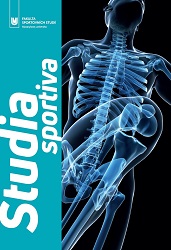Analýza úrovně antropometrických a silových charakteristik tenistů a tenistek ve věku 11−12 let
Analysis of the level of anthropometric and strength characteristics of male and female players aged 11–12
Author(s): Jiří Pačes, Jiří Zháněl, Tomáš Vodička, Pavel Mudra, Martin Vilím, Ondřej HubáčekSubject(s): Sports Studies
Published by: Masarykova univerzita nakladatelství
Keywords: inter-gender difference; hand dynamometer; strength; tennis; test
Summary/Abstract: The issues of the significance of strength capabilities in sport and tennis are dealt with by many authors, in tennis, the strength of the playing arm primarily manifests in the speed of strokes, serve and locomotion movement. The goal of this paper is analysis of basic anthropometric and strength levels of male and female players’, comparisons and evaluation of inter-gender differences of anthropometric and strength characteristic. The research sample consists of Czech junior male tennis players (n = 221) and female players (n = 193) in the ages between 11.0 and 12.9 years. The data for this research were gathered during 2000-2010 period by regular testing using a test battery TENDIAG 1. Analysis of acquired data shows normal distribution characteristics. Values of measured anthropometric and strength levels statistic characteristic variables in the set of male tennis players (n = 221, body height: H = 155.10 ± 7.62, body weight: W = 43.50 ± 6.68, strength of playing hand: SH = 25.14 ± 4.59, relative strength of playing hand: RS = 0.58 ± 0.09) and female tennis players (n = 193, body height: H = 154.60 ± 6.94, body weight: W = 43.49 ± 7.71, maximum strength of playing hand: SH = 23.08 ± 4.61, relative strength of playing hand RS = 0.53 ± 0.09). Inter-gender differences between male and female tennis players were assessed using Cohen’s d values, substantively significant differences in mean values between male and female players files were detected only in the relative strength of gaming hand (d = 0.56, mean effect) and maximum strength level of game hand (d = 0.45, low effect). Size of effect was significant in the sample tennis players demonstrated between H and W (r = 0.71, r2 = 0.50; mean effect), among H and MS (r = 0.59, r 2 = 0.35; mean effect) and between MS and W (r = 0.59, r 2 = 0.35, mean effect). In a group of female tennis players has been demonstrated size of effect relation between H and W (r = 0.75, r 2 = 0.56; mean effect), among W and MS (r = 0.64, r 2 = 0.41, mean effect) and also between the maximum and the relative strength (r = 0.58, r 2 = 0.34; mean effect).
Journal: Studia sportiva
- Issue Year: 10/2016
- Issue No: 1
- Page Range: 129-134
- Page Count: 5
- Language: Czech

